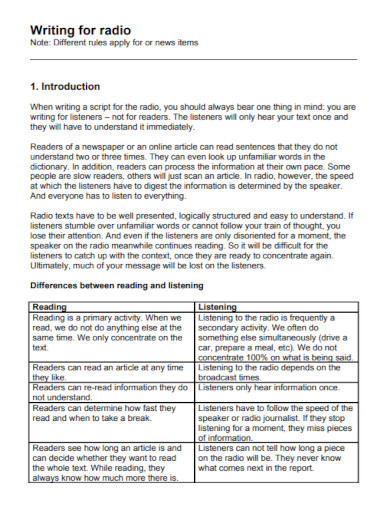
Thank You Letter for Appreciation – 19+ Free Word, Excel, PDF Format Download!
Letters expressing words that convey appreciation is a methodology that has been in existence since time immemorial yet many of…
Nov 28, 2024
Script writing is a captivating art form that brings stories to life, whether for the big screen, stage, or digital media. It’s the foundation of every compelling narrative, weaving dialogue, action, and character development into a cohesive and engaging script. For those seeking to craft their own scripts or communicate ideas effectively, letter templates can be an invaluable resource. These templates provide a structured way to organize thoughts and ideas, ensuring clarity and creativity go hand in hand. Whether you’re a seasoned writer or a beginner exploring the world of scriptwriting, the right tools and techniques can transform your concepts into powerful storytelling masterpieces.

The title page contains essential details:
Each scene starts with a heading that includes:
INT. LIVING ROOM – NIGHTWrite clear, concise descriptions of actions and settings.
The room is dimly lit. A shadow moves across the wall.Center the character’s name above the dialogue. Use all caps.
Example:
JESSICA
Write the character’s speech below their name.
JESSICAI can't believe this is happening.Use sparingly to show how a line is delivered or clarify an action during speech.
Example:
JESSICA
(whispering) We need to leave now.
Place transitions like FADE OUT, CUT TO, or DISSOLVE TO on the right margin. Use them only when necessary.




There are templates in Microsoft Word Format that are highly popular among users. Sample Template creation involves the following steps:-
Those who work with Microsoft Windows system software can use the simple Word document as a script template. The user needs to open a Blank ID Card Template in Microsoft Word and then save it as the SCRIPT TEMPLATE. The user can use the template to author scripts. There are other aspects of writing scripts, some of which are self-explanatory and help the user in writing the scripts.



To script a film, a film writer can use any ordinary white paper but it is not suggested and instead, the film writers are advised to use Script Writing Templates. The reason is simple. The printable templates augment the attractiveness of the scripts. If the movie idea is good but the script is poor, not formatted properly then there are lesser chances of it getting read by the audiences at large. Therefore, it is advised on the part of the writers to use script basic templates as they attract the reader’s attention.

The format templates in question are classified based on their style and format. There are physical formats, screenplay formats.

 dw.com
dw.com csbsju.edu
csbsju.edu gmj.manipal.edu
gmj.manipal.edu frankwbaker.com
frankwbaker.com
Begin with a compelling and original concept. Identify the core theme, the main characters, and the conflict that drives the story.
Organize your script into a three-act structure:
Craft a one-sentence summary of your script that highlights the protagonist, their goal, and the conflict they face.
Design characters with depth by defining their personalities, motivations, and how they evolve throughout the story.
Ensure your script is easy to read by using proper formatting:
Focus on storytelling while writing the first draft. Revise it to improve clarity, pacing, and character arcs.
Share your script with trusted peers or mentors for constructive criticism. Incorporate feedback, proofread for errors, and polish the final version for submission.

Develop a unique and engaging story idea that captures attention. Ensure your concept has a clear theme and conflict.
Write with your target audience in mind. Tailor the tone, language, and pacing to resonate with their expectations.
Organize your story into beginning, middle, and end:
Craft characters with depth, clear motivations, and believable development. Avoid stereotypes and ensure they contribute to the plot.
Use actions, visuals, and subtext to convey emotions and plot points. Avoid long expositions and overly descriptive dialogue.
Write dialogue that reflects each character’s personality and sounds realistic. Avoid making it too formal or overly explanatory.
Your first draft is just the beginning. Review, revise, and polish your script to ensure it’s concise, engaging, and professionally formatted.
Script writing is the art of creating stories for visual or audio media, including dialogue, actions, and scene descriptions. Example: A screenplay for a movie like Inception outlines character dialogue and scenes such as “INT. DREAMWORLD – NIGHT.”
Screenwriting can be challenging as it requires creativity, technical skills, and a deep understanding of storytelling and character development. However, with practice and proper guidance, it becomes easier to master.
Yes, script writing remains in demand across various media platforms. The rise of streaming services has increased the need for original content, leading to more opportunities for screenwriters. Additionally, the expansion of digital media and online platforms has created new avenues for scriptwriters in web series, podcasts, and interactive content. However, the industry is competitive, and success often requires a combination of talent, networking, and persistence.

Letters expressing words that convey appreciation is a methodology that has been in existence since time immemorial yet many of…

Always have your letter written on time before the day you want to quit the job. A period of two…

It isn’t easy to talk to someone you have only met for the first time. Opening up to them, especially…

There will always come a time when a nurse decides to leave an institution and move on to other opportunities,…

Do you want to adopt a child or a sister and brother and become the best parents? You may have…

From time to time, you may be called upon to write a reference letter for a colleague. In that case,…

How to Write Invitation Letter Heading Living in a fast-paced world is never easy, but thanks to modern-day internet technology,…

Writing a termination letter is not easy. The situation is usually further complicated if the parties involved in termination are…

When the bell to put away your work cloth rings, you know it is time to pick up a retirement…